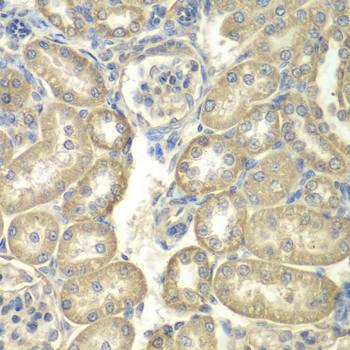Metabolism Antibodies 1
Anti-ACSL5 Antibody (CAB1270)
- SKU:
- CAB1270
- Product Type:
- Antibody
- Reactivity:
- Human
- Reactivity:
- Mouse
- Reactivity:
- Rat
- Host Species:
- Rabbit
- Isotype:
- IgG
- Antibody Type:
- Polyclonal Antibody
- Research Area:
- Metabolism
Description
| Antibody Name: | Anti-ACSL5 Antibody |
| Antibody SKU: | CAB1270 |
| Antibody Size: | 20uL, 50uL, 100uL |
| Application: | WB IHC |
| Reactivity: | Human, Mouse, Rat |
| Host Species: | Rabbit |
| Immunogen: | Recombinant fusion protein containing a sequence corresponding to amino acids 500-739 of human ACSL5 (NP_057318.2). |
| Application: | WB IHC |
| Recommended Dilution: | WB 1:500 - 1:2000 IHC 1:20 - 1:100 |
| Reactivity: | Human, Mouse, Rat |
| Positive Samples: | HepG2, HL-60, Mouse liver, Rat liver |
| Immunogen: | Recombinant fusion protein containing a sequence corresponding to amino acids 500-739 of human ACSL5 (NP_057318.2). |
| Purification Method: | Affinity purification |
| Storage Buffer: | Store at -20'C. Avoid freeze / thaw cycles. Buffer: PBS with 0.02% sodium azide, 50% glycerol, pH7.3. |
| Isotype: | IgG |
| Sequence: | GQTE CTGG CTFT LPGD WTSG HVGV PLAC NYVK LEDV ADMN YFTV NNEG EVCI KGTN VFKG YLKD PEKT QEAL DSDG WLHT GDIG RWLP NGTL KIID RKKN IFKL AQGE YIAP EKIE NIYN RSQP VLQI FVHG ESLR SSLV GVVV PDTD VLPS FAAK LGVK GSFE ELCQ NQVV REAI LEDL QKIG KESG LKTF EQVK AIFL HPEP FSIE NGLL TPTL KAKR GELS KYFR TQID SLYE HIQD |
| Gene ID: | 51703 |
| Uniprot: | Q9ULC5 |
| Cellular Location: | Endoplasmic reticulum, Endoplasmic reticulum membrane, Mitochondrion, Mitochondrion outer membrane, Single-pass type III membrane protein |
| Calculated MW: | 73kDa/75kDa/82kDa |
| Observed MW: | 70-76kDa |
| Synonyms: | ACSL5, ACS2, ACS5, FACL5 |
| Background: | The protein encoded by this gene is an isozyme of the long-chain fatty-acid-coenzyme A ligase family. Although differing in substrate specificity, subcellular localization, and tissue distribution, all isozymes of this family convert free long-chain fatty acids into fatty acyl-CoA esters, and thereby play a key role in lipid biosynthesis and fatty acid degradation. This isozyme is highly expressed in uterus and spleen, and in trace amounts in normal brain, but has markedly increased levels in malignant gliomas. This gene functions in mediating fatty acid-induced glioma cell growth. Three transcript variants encoding two different isoforms have been found for this gene. |
| UniProt Protein Function: | ACSL5: Acyl-CoA synthetases (ACSL) activate long-chain fatty acids for both synthesis of cellular lipids, and degradation via beta-oxidation. ACSL5 may activate fatty acids from exogenous sources for the synthesis of triacylglycerol destined for intracellular storage. Utilizes a wide range of saturated fatty acids with a preference for C16-C18 unsaturated fatty acids. It was suggested that it may also stimulate fatty acid oxidation. At the villus tip of the crypt-villus axis of the small intestine may sensitize epithelial cells to apoptosis specifically triggered by the death ligand TRAIL. May have a role in the survival of glioma cells. Belongs to the ATP-dependent AMP-binding enzyme family. 3 isoforms of the human protein are produced by alternative splicing. |
| UniProt Protein Details: | Protein type:Lipid Metabolism - fatty acid; Membrane protein, integral; Ligase; Mitochondrial; EC 6.2.1.3 Chromosomal Location of Human Ortholog: 10q25.2 Cellular Component: endoplasmic reticulum membrane; mitochondrial outer membrane; mitochondrion; membrane; endoplasmic reticulum; mitochondrial inner membrane; nucleolus; integral to membrane; nucleus Molecular Function:ATP binding; long-chain-fatty-acid-CoA ligase activity Biological Process: triacylglycerol biosynthetic process; cellular lipid metabolic process; long-chain fatty acid metabolic process |
| NCBI Summary: | The protein encoded by this gene is an isozyme of the long-chain fatty-acid-coenzyme A ligase family. Although differing in substrate specificity, subcellular localization, and tissue distribution, all isozymes of this family convert free long-chain fatty acids into fatty acyl-CoA esters, and thereby play a key role in lipid biosynthesis and fatty acid degradation. This isozyme is highly expressed in uterus and spleen, and in trace amounts in normal brain, but has markedly increased levels in malignant gliomas. This gene functions in mediating fatty acid-induced glioma cell growth. Three transcript variants encoding two different isoforms have been found for this gene. [provided by RefSeq, Jul 2008] |
| UniProt Code: | Q9ULC5 |
| NCBI GenInfo Identifier: | 13431659 |
| NCBI Gene ID: | 51703 |
| NCBI Accession: | Q9ULC5.1 |
| UniProt Related Accession: | Q9ULC5 |
| Molecular Weight: | |
| NCBI Full Name: | Long-chain-fatty-acid--CoA ligase 5 |
| NCBI Synonym Full Names: | acyl-CoA synthetase long chain family member 5 |
| NCBI Official Symbol: | ACSL5 |
| NCBI Official Synonym Symbols: | ACS2; ACS5; FACL5 |
| NCBI Protein Information: | long-chain-fatty-acid--CoA ligase 5 |
| UniProt Protein Name: | Long-chain-fatty-acid--CoA ligase 5 |
| UniProt Synonym Protein Names: | Long-chain acyl-CoA synthetase 5; LACS 5 |
| Protein Family: | Long-chain-fatty-acid--CoA ligase |
| UniProt Gene Name: | ACSL5 |
| UniProt Entry Name: | ACSL5_HUMAN |
View AllClose








